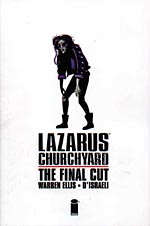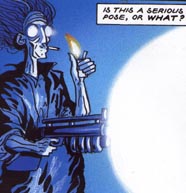>> The Friday Review: Pubo
>> The Friday Review: Get Your War On
More...

 Writer: Warren Ellis
Writer: Warren Ellis
Artist: D'Israeli
Letterers: HV Derci & Mary Green
Price: $14.95
Publisher: Image Comics
ISBN: 1-58240-180-2
It was in the pages of BLAST in the early 90s that Warren Ellis first introduced us to the strange and awkward figure of Lazarus Churchyard. At the time, in the UK, newsstand comics magazines seemed to have a healthy sense of credibility and relevance. This was the era of DEADLINE, CRISIS, STRIP, REVOLVER and BLAST - all of which were unashamedly on display in high street stores across the country.
Unfortunately, it transpired that although they were being seen, they weren't being sold. Of these titles, only DEADLINE and CRISIS can be said to have notched up halfway decent runs, and only DEADLINE achieved the kind of 'mainstream' success outside of the comic book ghetto that all these titles were obviously aiming for.
BLAST was probably the runt of the litter. While REVOLVER - published by Fleetway, which also put out 2000AD - could boast the likes of DARE by Grant Morrison and Ryan Hughes, and PURPLE HAZE - a biography of Jimi Hendrix by respected music journalist Charles Shaar Murray - BLAST had evolved out of the well respected but poor-selling comics newsmagazine SPEAKEASY. It featured new strips like LAZARUS CHURCHYARD, but they rubbed shoulders with already heavily reprinted material like Paul Chadwick's CONCRETE and Sanchez Abuli's TORPEDO 1936.
BLAST folded after seven issues (as did REVOLVER), although LAZARUS CHURCHYARD was resurrected by Ellis the following year at the ill-fated Tundra UK for a three issue mini series, reprinting the BLAST material and adding to it. A collection was published just before Tundra UK itself folded, and Ellis moved on to work in mainstream American comics for the next few years. He ended up doing rather well, and it's because of the success he's achieved in recent years that Image has decided to collect and rerelease his first major comics work.
The concept behind LAZARUS CHURCHYARD isn't a complicated one - Churchyard was a 21st Century criminal/cyberterrorist, as well as the recipient of an experimental surgical technique known as 'plasborging'. His body is now chiefly composed of an intelligent, indestructible living plastic, and to all intents and purposes he is immortal. Whether or not he initially liked that idea isn't really dealt with, as the stories in THE FINAL CUT pick up his tale four hundred years later - by which point he's pretty much grown tired of being alive.
The first story arc in THE FINAL CUT is 'Virtual Kiss', which originally ran in BLAST 1-6. 'Virtual Kiss' serves to introduce Churchyard and his world and, despite a few hackneyed Cyberpunk-isms, it has dated quite well.
 Churchyard is approached by a representative of the corporation known as Isis Elek (which owns England - now known as Savoy) with a proposition. An unknown party is attacking Isis Elek through its corporate 'Datasea' - a kind of Intranet version of Bill Gibson's cyberspace. The Datasea operators are being (messily) killed whenever they jack in, and unless something is done about it quickly, Isis Elek could quite easily find itself paralysed by the attack.
Churchyard is approached by a representative of the corporation known as Isis Elek (which owns England - now known as Savoy) with a proposition. An unknown party is attacking Isis Elek through its corporate 'Datasea' - a kind of Intranet version of Bill Gibson's cyberspace. The Datasea operators are being (messily) killed whenever they jack in, and unless something is done about it quickly, Isis Elek could quite easily find itself paralysed by the attack.
Unfortunately, the firm's top Datasea scientist, Maxyne Bruckner, has been murdered by a group of Caledonian separatists. Though Bruckner's memories and personality were uploaded into the Datasea when she died, the company has been unable to contact her, as their operators' brains keep melting whenever they try to get in.
However, Churchyard's brain is indestructible; and as such he should be able to jack into the Datasea without risk and contact Bruckner's uploaded personality. In return, Isis Elek is offering to kill Churchyard, having developed the technology to shear him free of the symbiotic plastic at a genetic level. He accepts and travels to Savoy, where murder and mayhem ensue.
Originally envisioned as a sort of 'English Cyberpunk', Ellis pretty much ignores that abominable idea and instead crafts a series of stories that have a lot more in common with the work of the British New Wave of the sixties and seventies - people like Brian Aldiss, J.G. Ballard, and Michael Moorcock.
In his introduction, Ellis refers to it as 'Decadent SF' - which isn't a bad label, as they go. These stories are demented, free form fantasies - blackly humorous excursions into an impossible future world very different from our own, and yet at the same time easily understandable. Ellis handles all this with no small amount of skill, and back in those days his imagination was rampant - check out the Slamcars, the Neonates and the 'Grimoire of Sharp-Tongue Action'. I'm not sure where the 'suits made of lager' that D'Israeli mentions in his introduction crop up, but it's the kind of thing you come to expect to see in THE FINAL CUT.
All that said, it's still an early and occasionally unpolished work. The exposition is often a little clumsy, and the overly clever dialogue comes across as stylish rather than substantive in places. Next to Ellis' current ongoing sci-fi satire TRANSMETROPOLITAN, which has covered similar ground in a similar fashion, it feels a little raw. Also, Churchyard gets a little angsty from time to time, though this might be expected of an immortal who wants nothing more than to die, and Ellis' pacing is such that one can never get too bogged down by these admittedly minor qualms. In fact, given that THE FINAL CUT isn't a graphic novel so much as a collection of short stories, it flows surprisingly well.
 One criticism that might be levelled at Ellis is that his plots and characters are sometimes little more than anorexic skeletons on which to hang his mad ideas. There's certainly an element of that here - in many ways it was unavoidable, given the fact Ellis had just seven-odd pages a month in BLAST to develop Churchyard's character. Yet in among all the manic violence and technology fetishism there's his trademark moments of melancholy introspection and reflection, which serve to counter-act the nihilism and emphasise the very humanist message that lies at the heart of his work.
One criticism that might be levelled at Ellis is that his plots and characters are sometimes little more than anorexic skeletons on which to hang his mad ideas. There's certainly an element of that here - in many ways it was unavoidable, given the fact Ellis had just seven-odd pages a month in BLAST to develop Churchyard's character. Yet in among all the manic violence and technology fetishism there's his trademark moments of melancholy introspection and reflection, which serve to counter-act the nihilism and emphasise the very humanist message that lies at the heart of his work.
Nowhere is this more evident than in the real gem of the collection - a new Churchyard short by Ellis and D'Israeli called 'Finality'. 'Finality' opens thirty years after the events in the 'Inspector Sleep' storyline, as Churchyard narrates the story of his conception to an acquaintance on a roof in Reykjavik. It's a sad and moving piece that provides the collection (and the story of Lazarus Churchyard) with a touching sense of closure.
While Ellis certainly deserves his fair share of credit, special mention must be made of D'Israeli's art - without which Churchyard could easily have ended up looking like a second-rate 2000AD character. Reading 'Virtual Kiss' in BLAST all those years ago, it was D'Israeli's name that stuck in my mind, and I associated with the strip rather than Ellis'.
D'Israeli superbly defines the aesthetic of Churchyard's world through his beautiful full colour painted art. His surreally exaggerated futurescapes and jagged, emaciated figures give the whole thing a bizarre, dream-like feel that both fascinates and disturbs. It also manages to look completely different from anything else I've seen in SF comics over the last ten years.
D'Israeli is on top form here, and while you could argue that the writing is only the early, unpolished work of a future great, the art is undoubtedly the product of one of the medium's great unsung talents in his prime. His sense of design, too, is second to none - note the story-sensitive layouts and shifting colour schemes. Even the design of the collection itself - the work of both D'Israeli and Mike Heisler - is pretty nifty, and this was definitely one of the more attractive looking books on the shelves of comics stores during 2001.
THE FINAL CUT is a real treat for both the Ellis fan and the SF reader alike. While it's neither the most ambitious, nor the most polished work out there, it's still a delirious and hugely enjoyable ride through the imaginations of two of the better creators to emerge out of the early nineties UK comics scene. With so much quality work from this period probably gone forever, it's a real pleasure to see at least some of it not just surviving, but surviving in style.

This article is Ideological Freeware. The author grants permission for its reproduction and redistribution by private individuals on condition that the author and source of the article are clearly shown, no charge is made, and the whole article is reproduced intact, including this notice.


